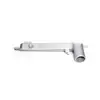Mobile:+86-311-808-126-83
Email:info@ydcastings.com
Practical Solutions for Managing Car Oil Leaks with an Effective Drip Pan System
Understanding Car Oil Drip Pans Essential Tools for Vehicle Maintenance
Car maintenance is a critical aspect of vehicle ownership, ensuring performance, longevity, and safety. Among the various tools and accessories used for car maintenance, the oil drip pan stands out as a crucial item, especially for DIY enthusiasts. This article delves into the importance of car oil drip pans, their types, uses, and tips for proper handling and disposal.
A car oil drip pan, also known as an oil catch pan, is designed to collect any oil that drips or spills during vehicle maintenance tasks, particularly during oil changes. When changing the oil, whether in a car, motorcycle, or any other motor vehicle, it is essential to contain the used oil properly. This not only helps in keeping the workspace clean but also minimizes environmental pollution.
Using an oil drip pan is relatively straightforward. First, position the pan directly beneath the engine’s oil drain plug or any area where oil is likely to spill. As you remove the drain plug, the used oil flows directly into the pan. Most drip pans have a wide, shallow design to maximize surface area, allowing for easy collection of oil and minimizing the risk of spills. Some models come with a spout feature for easier pouring out of the collected oil, making the process tidier.
car oil drip pan

There are various types of oil drip pans available on the market. The most common materials include plastic, metal, and rubber. Plastic pans are lightweight and easy to clean but may not withstand high heat or heavy use. Metal pans, while more durable, can be heavier and may corrode over time if not properly maintained. Rubber pans are flexible and can be easily manipulated but may wear out quicker than their metal counterparts. When selecting an oil drip pan, consider the size, material, and ease of use that best fits your needs.
One of the significant advantages of using an oil drip pan is its impact on the environment. Improper disposal of motor oil can have dire consequences for the ecosystem, leading to soil and water contamination. The United States Environmental Protection Agency (EPA) estimates that improperly disposed of motor oil can pollute up to a million gallons of fresh water. By using an oil drip pan, you contribute to responsible oil disposal practices. After collecting the used oil, it can be taken to an appropriate recycling center or a household hazardous waste collection site.
Proper maintenance of the oil drip pan itself is essential. After each use, it is advisable to clean the pan thoroughly to prevent any build-up that could compromise its future effectiveness. If the pan is plastic, ensure that you are using non-corrosive cleaning materials. For metal pans, a light scrub with soap and water is often sufficient. Additionally, always inspect your pan for any damages or cracks before use, as these can lead to leaks and spills, negating the purpose of the pan.
In conclusion, a car oil drip pan is an essential tool for anyone involved in vehicle maintenance. Not only does it facilitate a cleaner and more efficient oil change process, but it also plays a crucial role in protecting the environment. By choosing the right type of oil drip pan and following proper maintenance and disposal practices, you can ensure that your car maintenance routines contribute positively to both your vehicle's health and the planet. Investing in a quality oil drip pan is a small yet significant step towards responsible car ownership and environmental stewardship.
-
Why Should You Invest in Superior Pump Castings for Your Equipment?NewsJun.09,2025
-
Unlock Performance Potential with Stainless Impellers and Aluminum End CapsNewsJun.09,2025
-
Revolutionize Your Machinery with Superior Cast Iron and Aluminum ComponentsNewsJun.09,2025
-
Revolutionize Fluid Dynamics with Premium Pump ComponentsNewsJun.09,2025
-
Optimizing Industrial Systems with Essential Valve ComponentsNewsJun.09,2025
-
Elevate Grid Efficiency with High-Precision Power CastingsNewsJun.09,2025











